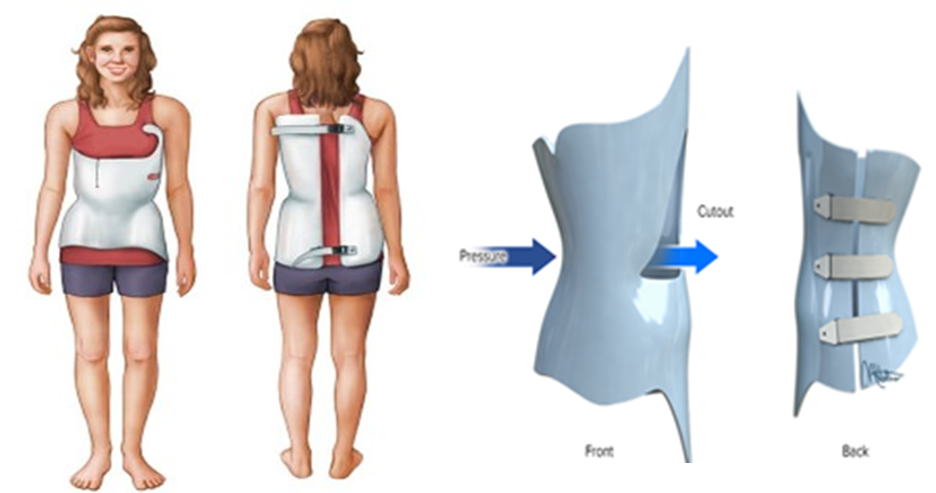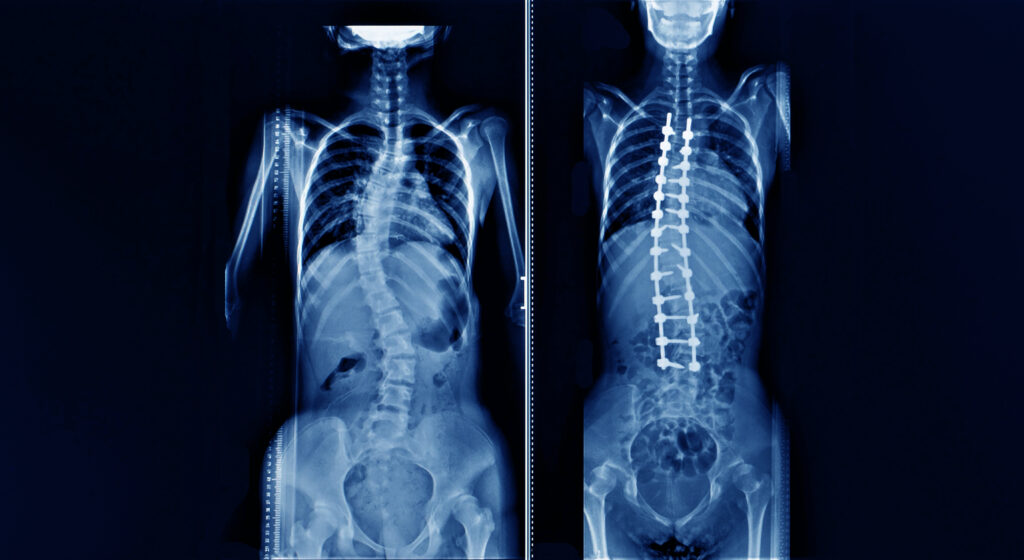Scoliosis
Scoliosis is a term used to describe any abnormal, sideways curvature of the spine.
Viewed from the back, a typical spine is straight. With scoliosis, the spine can curve in one of three ways:
- The spine can curve to the left, shaped like the letter “C”
- The spine can curve to the right, shaped like a backwards letter “C”
- The spine has two curves, shaped like the letter “S”.

Scoliosis is a sideways curvature of the spine that most often is diagnosed in adolescents. Most cases of scoliosis are mild, but some curves worsen as children grow. Severe scoliosis can be disabling. An especially severe spinal curve can reduce the amount of space within the chest, making it difficult for the lungs to function properly.
Some children will need to wear a brace to stop the curve from worsening. Others may need surgery to straighten severe curves.
Signs and symptoms of scoliosis may include:
- Uneven shoulders
- One shoulder blade that appears more prominent than the other
- Uneven waist
- One hip higher than the other
- One side of the rib cage jutting forward
- A prominence on one side of the back when bending forward
Risk factors for developing the most common type of scoliosis include:
- Age. Signs and symptoms typically begin in adolescence.
- Sex. Although both boys and girls develop mild scoliosis at about the same rate, girls have a much higher risk of the curve worsening and requiring treatment.
- Family history. Scoliosis can run in families, but most children with scoliosis don’t have a family history of the disease.
While most people with scoliosis have a mild form of the disorder, scoliosis may sometimes cause complications, including:
- Breathing problems
- Back problems
- Appearance
Treatment
Scoliosis treatments vary, depending on the severity of the curve. Children who have very mild curves usually don’t need any treatment at all, although they may need regular checkups to see if the curve is worsening as they grow. Bracing or surgery may be needed if the spinal curve is moderate or severe.
Factors to be considered include:
- Maturity. If a child’s bones have stopped growing, the risk of curve progression is low. That also means that braces have the most effect in children whose bones are still growing.
- Severity of curve. Larger curves are more likely to worsen with time.
- Sex. Girls have a much higher risk of progression than do boys.
Braces
If your child’s bones are still growing and he or she has moderate scoliosis, your doctor may recommend a brace. Wearing a brace won’t cure scoliosis or reverse the curve, but it usually prevents the curve from getting worse. This brace is almost invisible under the clothes, as it fits under the arms and around the rib cage, lower back and hips. Most braces are worn between 13 and 16 hours a day. A brace’s effectiveness increases with the number of hours a day it’s worn. Children who wear braces can usually participate in most activities and have few restrictions. If necessary, kids can take off the brace to participate in sports or other physical activities.

Surgery
Severe scoliosis typically progresses with time, so your doctor might suggest scoliosis surgery to help straighten the curve and prevent it from getting worse. Surgical options include:
- Spinal fusion. In this procedure, surgeons connect two or more of the bones in the spine (vertebrae) together so they can’t move independently.
- Expanding rod. If the scoliosis is progressing rapidly at a young age, surgeons can attach one or two expandable rods along the spine that can adjust in length as the child grows.
- Vertebral body tethering. This procedure can be performed through small incisions. Screws are placed along the outside edge of the abnormal spinal curve and a strong, flexible cord is threaded through the screws. When the cord is tightened, the spine straightens. As the child grows, the spine may straighten even more.
Complications of spinal surgery may include bleeding, infection or nerve damage.

